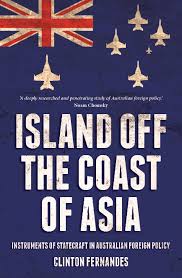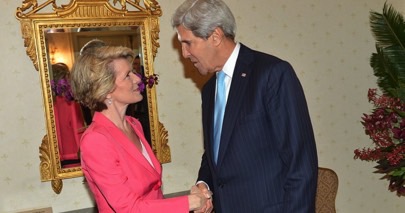
Island Off the Coast of Asia: Instruments of Statecraft in Australian Foreign Policy. By Clinton Fernandes. Monash University Publishing, Melbourne, 2018.
Reviewed by Richard Broinowski
Island off the Coast of Asia – Instruments of Statecraft in Australian Foreign Policy is a radical analysis of the genesis and development of Australia’s foreign policy. It is an essential if depressing read for those wishing to understand the origins of our external policies. Fernandes reveals on whose behalf the levers of power in Canberra operate, and why the term “national interest” has acquired such a slippery and ambiguous meaning.
Fernandes begins with a historical Australian perspective. The Battle of Trafalgar in October 1805 cleared the seas of contending Spanish and French navies and provided the Australian colonies with a hundred years of Royal Navy protection. During this time, the colonies became part of a global, white, Christian ascendancy, always siding with the colonisers and lacking sympathy for the colonised people. “Security” was as much about safeguarding the commercial interests of their protectors as it was about the prevention of invasion. The Australian colonies lost none of their dependence on an imperial power after Federation, only substituting America for Britain as the Commonwealth’s protector during and after WWII.
Fernandes shows how Australia’s priorities were reflected in its policies towards post-1945 de-colonisation in the Pacific.
 In joining the Americans in conflicts in Korea, the British in Malaya, and the Americans again in Vietnam, Australia used its foreign policy and military instruments to keep its great and powerful friends engaged in Asia. But these instruments were also used to overcome the threat of social transformation of former Asian colonies by preventing local nationalists — not Chinese or Russian Communists as is so frequently asserted by conservative bureaucrats in Canberra — from seizing the means of economic production. It is refreshing to see the author, with such impeccable credentials as having served in Australian Army Intelligence, giving such a radical interpretation.
In joining the Americans in conflicts in Korea, the British in Malaya, and the Americans again in Vietnam, Australia used its foreign policy and military instruments to keep its great and powerful friends engaged in Asia. But these instruments were also used to overcome the threat of social transformation of former Asian colonies by preventing local nationalists — not Chinese or Russian Communists as is so frequently asserted by conservative bureaucrats in Canberra — from seizing the means of economic production. It is refreshing to see the author, with such impeccable credentials as having served in Australian Army Intelligence, giving such a radical interpretation.
Thus, Syngman Rhee was appointed to run South Korea because he opposed a wave of radical nationalism unleashed by the defeat of Japanese oppressors after WWII. Tunku Abdul Rahman was favoured by the British to run Malaya because he was a member of the British-educated elite who could be relied on to protect British plantation and mining interests. In Vietnam, Ngo Dinh Diem, a conservative Catholic, was sympathetic to foreign capitalists and could be relied on to suppress the ambitions of the National Liberation Front. He was deposed only when he alienated the anti-communist elite.
Was Australia’s support for Indonesian independence from the Dutch an exception to Fernandes’ rule? Not according to him.
Canberra realised that the Dutch had had their day, and that Sukarno was showing competence as a local leader who could hold the country together. Only when Sukarno became too friendly with the Communist PKI did Australia, along with the Americans, decide that he had to go. After a massive blood-letting against the PKI, in which Americans were complicit, Sukarno was replaced by the less-nationalistic Suharto in 1966. By cracking down on unions, guaranteeing a low-wage economy, and relaxing workers’ health and safety rules, Suharto welcomed foreign capital and supported American corporate interests.
Fernandes pursues his theme in describing Canberra’s use of Australia’s legal, financial, and economic instruments. Australian adherence to the Law of the Sea Convention was based to a large extent on getting international recognition for an extended definition of our continental shelf.
Extensive taxpayer-funded surveys established boundaries ensuring that Australian and foreign petroleum companies could exploit vast sea-bed resources uncontested by rival companies. Canberra socialised the costs and risks of exploration in order to privatise the profits in the hands of a few large companies. Canberra’s judicial manipulations against Timor Leste ensured Australian-based companies received the lion’s share of the petroleum take-off in the Timor Sea.
Fernandes provides a complex history of Australia’s use of its financial instruments to maintain its priorities in such institutions as the Asian Development Bank, in its diplomacy to liberalise agricultural trade, in regional groupings such as ASEAN, and in multilateral negotiations such as the Uruguay Round. He is particularly effective in exposing how Australia lost the advantage time and again in bilateral free trade deals, particularly in relation to intellectual property rights. He points out that free trade agreements are always negotiated in secret by Canberra’s bureaucrats, with the tax-paying public unaware of the disadvantages they create and whom they are meant to benefit.
Fernandes pulls his disparate arguments together in his final chapter. He points out that on the Australian stock exchange, 20 firms account for 80 per cent of the market by capitalisation. They include financial institutions, mining, oil and gas companies, and farm-to-shelf agribusinesses. Of their 190 elite directors, the majority live in the eastern Sydney suburb of Mosman. Why, asks Fernandes, does the Australian government participate so enthusiastically in treaties that benefit private investors? The answer, he says, should be clear by now: it has always done so. The instruments of statecraft served private concentrations of wealth even before federation in 1901 and have continued to do so.
The Australian Labor Party has from time to time tried to buck the trend. RFX Connor as Whitlam’s Minerals and Energy Minister introduced a nationalist policy that would have given majority ownership of minerals and energy resources to Australians. Bob Hawke did so when he initiated the Cairns Group to free primary producing countries, both first and third world, from import tariffs. Julia Gillard tried to do so when she introduced a resources rent profits tax.
But according to Fernandes, and barring a global revolution, the trend is now set in concrete. “Today’s combination of product patents, global financial markets and internationally dispersed production results in Global Value Chains (GVCs) coordinated by transnational corporations.”
He endorses British scholar Nicola Phillips’ view that “firms, not states, will play the major role in determining what will be produced where and on what terms, and what will be traded and on what terms.”
The most important decisions, concludes Fernandes, happen in the private sector. The “national interest” amounts in practice to the public bearing the costs and risks of diplomacy, law, investment, research, negotiations, espionage, and other instruments of statecraft, while small groups in control of vast concentrations of capital benefit disproportionately.
His argument is bracing and hard to argue with. It provides a welcome proportionality to the confected fears manufactured by the political class in Canberra, and their pretentions that the political party with a majority in the House of Representatives runs the Australian ship of state.
* Richard Broinowski was Australian Ambassador to Vietnam, the Republic of Korea, and to Mexico, Central American Republics and Cuba, and is immediate past president of AIIA in New South Wales.
Republished with permission from AIIA



